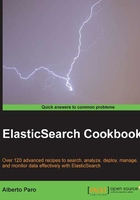
Conventions
In this book, you will find a number of styles of text that distinguish between different kinds of information. Here are some examples of these styles, and an explanation of their meaning.
Code words in text, database table names, folder names, filenames, file extensions, pathnames, dummy URLs, user input, and Twitter handles are shown as follows: "Open the config/elasticsearch.yml file with an editor of your choice."
A block of code is set as follows:
path.conf: /opt/data/es/conf path.data: /opt/data/es/data1,/opt2/data/data2 path.work: /opt/data/work path.logs: /opt/data/logs path.plugins: /opt/data/plugins
When we wish to draw your attention to a particular part of a code block, the relevant lines or items are set in bold:
{
"order": {
"_uid": {
"store": "yes"
},
"_id": {
"path": "order_id"
},
"properties": {
"order_id": {
"type": "string",
"store": "yes",
"index": "not_analyzed"
},
Any command-line input or output is written as follows:
bin/plugin -install elasticsearch/elasticsearch-mapper-attachments/1.9.0
New terms and important words are shown in bold. Words that you see on the screen, in menus or dialog boxes for example, appear in the text like this: " The Any Request [+] tab allows executing custom query. On the left-hand side there are the following options:".